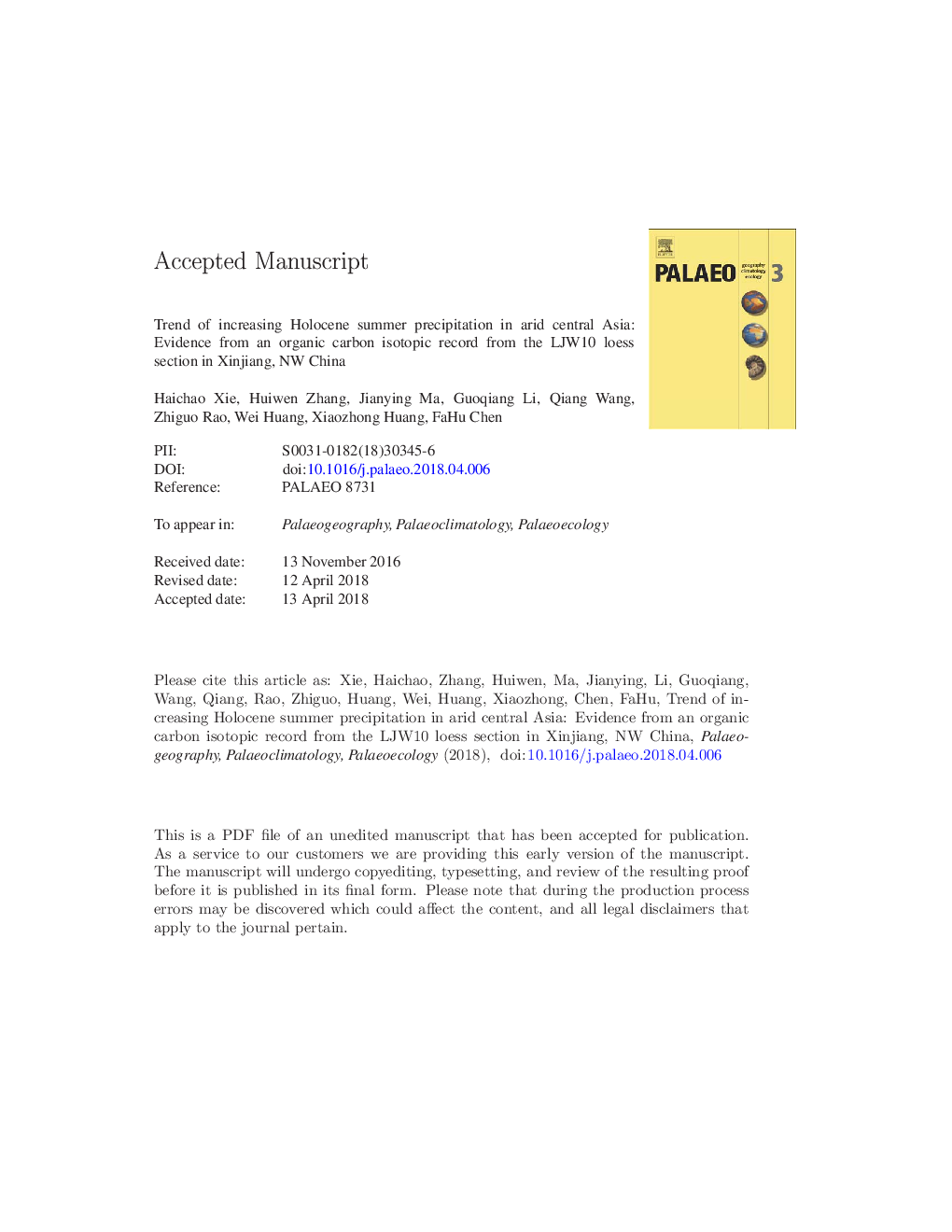| کد مقاله | کد نشریه | سال انتشار | مقاله انگلیسی | نسخه تمام متن |
|---|---|---|---|---|
| 10223625 | 1701039 | 2018 | 42 صفحه PDF | دانلود رایگان |
عنوان انگلیسی مقاله ISI
Trend of increasing Holocene summer precipitation in arid central Asia: Evidence from an organic carbon isotopic record from the LJW10 loess section in Xinjiang, NW China
دانلود مقاله + سفارش ترجمه
دانلود مقاله ISI انگلیسی
رایگان برای ایرانیان
موضوعات مرتبط
مهندسی و علوم پایه
علوم زمین و سیارات
فرآیندهای سطح زمین
پیش نمایش صفحه اول مقاله

چکیده انگلیسی
Due to the lack of reliable climatic proxies, the variability of precipitation in “Westerlies-dominated” arid central Asia (ACA) during the Holocene is debated. Here, we present a high-resolution (ca. 100â¯years per sample) organic carbon isotopic composition (δ13Corg) record from bulk samples from the Lujiaowan10 section in the northern piedmont of the Tienshan Mountains, Xinjiang Province, northwestern China. A robust chronology is provided by K-feldspar pIRIR dating. During the early to middle Holocene, from 12â¯ka to 6â¯ka (1â¯kaâ¯=â¯1000â¯years ago), the δ13Corg values are relatively invariant with an average of around â22.5â°. After about 6â¯ka, the δ13Corg values exhibit an overall negative trend with the most negative value of â25.2â° occurring in the uppermost part of the section, within the interval of Holocene soil formation. Our investigation of the relationship between modern climatic variables and surface soil δ13Corg values from the region reveals a significant negative correlation between surface soil δ13Corg and summer precipitation amount (June to August). Therefore, we used the calibration model between summer precipitation amount and surface soil δ13Corg to quantitatively reconstruct the Holocene summer precipitation history of the study area. Our results indicate that summer precipitation in the region was the lowest (ca. 85â¯mm) during the early to middle Holocene (12-6â¯ka); however, after 6â¯ka, the precipitation increased continuously to about 137â¯mm per year at the present. Our reconstruction is generally consistent with climate simulation results and with regional effective moisture records. Thus, we conclude that the highest summer precipitation, and therefore the wettest climate, occurred in the late Holocene. Decreasing Northern Hemisphere summer insolation may have effected a change in the CGT (circumglobal teleconnection) from a positive to negative phase and, together with more negative trends in AO (Arctic Oscillation) or NAO (North Atlantic Oscillation), may have been responsible for the observed pattern of summer precipitation evolution.
ناشر
Database: Elsevier - ScienceDirect (ساینس دایرکت)
Journal: Palaeogeography, Palaeoclimatology, Palaeoecology - Volume 509, 15 November 2018, Pages 24-32
Journal: Palaeogeography, Palaeoclimatology, Palaeoecology - Volume 509, 15 November 2018, Pages 24-32
نویسندگان
Haichao Xie, Huiwen Zhang, Jianying Ma, Guoqiang Li, Qiang Wang, Zhiguo Rao, Wei Huang, Xiaozhong Huang, FaHu Chen,